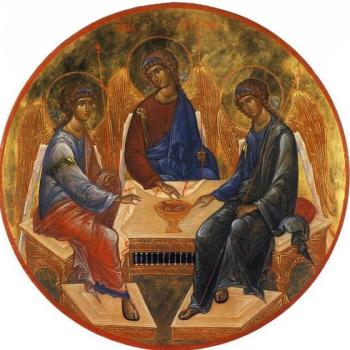The heart of the fourth section is a series of practical lessons for the everyday life of the Christian community, no doubt taken from an already existing collection of Jesus' "words": on the power of prayer over demons, on service and childlike simplicity, on openness and ecumenical recognition of all who "use Jesus' name" (9:38-40), on charity, on avoiding scandal, on respecting God's intention regarding marriage, on riches, finally on childlike simplicity once again.
This collection of "words of Jesus for practical situations" (as we may term it) takes on a new meaning in the context in which Mark places it: namely, as a fourth moment of faith learning. Mark shows that these words are not merely typical answers to practical problems, but concrete ways of accepting suffering, doubt, and controversy as a normal part of Christian living. For every future generation of Christians they define the difficult conditions of discipleship that must be accepted once a faith commitment is made.
The fifth section (10:33-13:37) clarifies the true role of Jerusalem for Jesus' mission. Jerusalem is the city of David and of Jesus, Son of David. Before Jesus was put to death, he actually confronted the authorities of Judaism and refuted all the specious and merely human arguments concerning the temple, God's promise to favor Israel, the resurrection of the dead, the law, and David's role in the history of salvation. By his refutation he prepared his disciples to understand correctly the sense of their own religion: that is, as it is explained in the "Old" Testament. This would be an important stage in the disciples' "resurrected" understanding of Jesus, once he was gone.
Not only had Jesus prepared them in advance to understand the meaning of his final suffering; he had also given them a key to unlock the Old Testament prophecies concerning God's election of a chosen people, a land, and a city. He had taught them to transfer their allegiance from David's city to David's son. The resurrection focused their attention on Jesus, who had clarified in advance how the Old Testament (the story of Jerusalem) contains the language and symbols needed to understand how he could be the Messiah. This is, therefore, an important new addition to what faith is and what theology reflects on. It gives a basis for understanding how God speaks in symbols and in history. His word Jesus is not just a point on a line, a "that," but the line itself -- the whole salvation history of Israel.
The sixth section (chaps. 14-16) makes it clear, however, that the meaning of Jerusalem and salvation history, as well as the meaning of all Jewish religious customs -- especially the Passover is Jesus crucified. He is our Passover. We are invited ultimately to live in relationship to, to be and to celebrate, his "body" given for us, and to grow spiritually to the extent that we "fill up what is wanting in the suffering of Christ." In itself, Jesus' crucifixion is an historical event that simply happens and cannot be explained: it is once and for all. As a new stage in faith and a new element of theology, it is the affirmation of a mystery: something has happened unexpectedly and cannot ultimately be explained.
In a way faith begins here! -- both for Jesus' disciples, who have gone through the entire series of events and faith learning, and for anyone. All the previous stages of preparation would lead merely to a religious gnosis if they were thought of as a rational, human solution, a kind of religious dialectic that a person goes through to find truth. This event, Jesus' death and his resurrection, accepted fully and freely, puts a stop to all such human pretensions. It forces us, for the first time, to accept what seems unacceptable and should not be able to happen: God's Son is helpless in the face of evil, but also God is revealed as resurrected in the suffering Jesus.
If this defeat and victory are accepted in faith, and if the source of this faith is not "our ideas" but God, then God's victory, his affirmation of Jesus' life called the resurrection, becomes the ground for witness to the power of goodness, truth, and meaning in God the Father, Son, and Spirit. Jesus, with whom the disciples lived, through whose teaching and example they learned about faith -- this same Jesus is a resurrected content of faith, a presence. For this reason Mark can end his Gospel with the empty tomb: Jesus' identity, kept secret until this moment, is now revealed. The disciples of Jesus, after the shock and pain of departure, experience his resurrected life and know it is constituted by all the things he said and did.
Mark and the Christian community, persevering in faith until the end -- until faith's true beginning in the resurrection with its revelation that the tomb cannot contain him who is living -- now retrace the prehistory of their faith, its genesis through the stages of their encounter, acceptance, and learning experiences with Jesus -- and the resurrection. The "necessary" moments of incomprehension, infidelity, hesitation, but also of ecstatic joy and recognition of Jesus' wisdom in interpreting the Scriptures, are now seen as necessary.




